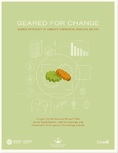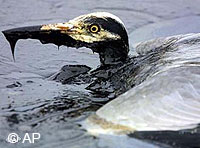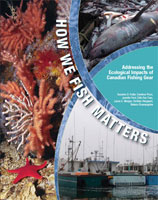
News |
- Hydro Development Threatens Nopiming
- Polar Bear Focus of National Round Table
- Canada Building A Green Economy
- CPAWS Supports Green Forestry Industry
- Energy Efficiency for Commercial Buildings
- Manitobans To Conserve Water
- Phosphorus Removal Will Save Lake
- Syncrude Sued Over Bird Deaths
- Fishing Gear Impacts Ranked
- Scientists Find New Forest with Google Earth
- Métis Hunting Rights Confirmed
- Reform For Biofuel Subsidies
| Hydro Development Threatens Nopiming | 30 January 09 |
 Manitoba Hydro is offering a $794,000 subsidy for a new hydro distribution grid for cottagers in remote Nopiming Provincial Park. To date no public proposal has been filed and no public information is posted. Manitoba Hydro is offering a $794,000 subsidy for a new hydro distribution grid for cottagers in remote Nopiming Provincial Park. To date no public proposal has been filed and no public information is posted. Environmental issues and concerns in the remote park are not addressed in the talks being held behind closed doors. Cottagers who are promoting the hydro project in Nopiming are restricting access to information about the proposed project and the impacts it will have in the park. The Manitoba government has committed to stop logging in the park, yet 30 acres of trees will have to be removed for the new hydro line. Manitoba Conservation and Manitoba Hydro are both silent on what criteria are being used to evaluate and approve the significant use of land in a park that includes protected areas for woodland caribou. Concerned citizens can contact Manitoba Conservation, Minister's Office: (204) 945-4695, or email at Mike.Keenan@leg.gov.mb.ca Sources: Manitoba Wildlands |
|
 Print version Print version |
Top |
| Polar Bear Focus of National Round Table | 29 January 09 |
 Canada's Environment Minster Jim Prentice hosted a national round table on the ionic polar bear January 2009 in Winnipeg. Inuit, scientists, environmentalists, and governmental officials met to discuss current threats and future action. Canada's Environment Minster Jim Prentice hosted a national round table on the ionic polar bear January 2009 in Winnipeg. Inuit, scientists, environmentalists, and governmental officials met to discuss current threats and future action. Canada is home to about two-thirds of the world's polar bears but scientists warn that dramatic losses of sea ice, over hunting, and industrial activity is threatening their survival. Prentice said the focus now is on short-term goals to address conservation. The World Wildlife Fund Canada identifies at least four major steps needed to safeguard the polar bear: develop a North American Conservation Action Plan, provide strong leadership to reduce all main threats, including climate change; full protection of all critical habitats for polar bears; and major increases in resources to for scientific research. View January 15, 2009 CBC articleView January 12, 2009 WWF article View WWF-Canon Polar Bear Tracker View January 16, 2009 Canadian Press article Visit Polar Bear International website Sources: CBC, WWF Canada, Canadian Press, Polar Bear International |
|
 Print version Print version |
Top |
| Canada Building A Green Economy | 26 January 09 |
 The Canadian Wind Energy Association (CANWEA) is calling for a plan that would see 20 percent of electricity generated in Canada from wind by 2025. The industry association is advising the federal government to include wind energy as a tool to boost the economy in the early federal budget being released in the last week of January 2009. The Canadian Wind Energy Association (CANWEA) is calling for a plan that would see 20 percent of electricity generated in Canada from wind by 2025. The industry association is advising the federal government to include wind energy as a tool to boost the economy in the early federal budget being released in the last week of January 2009.Wind Vision 2025 - Powering Canada's Future, released by CANWEA, states there will be close to $1-trillion by 2020 in global investments for new wind energy projects. Canada will need to implement bold measures to accommodate wind project developers. CanWEA is pushing for government to put a price on carbon emissions that will stimulate a demand for wind energy. CANWEA wants Canada to become a clean energy superpower by building wind-friendly transmission infrastructure, stimulating wind power equipment manufacturing, and streamlining permitting and approval processes for wind projects. View October 2008 CANWEA report, Wind Vision 2025 - Powering Canada's Future (PDF)View January 12, 2008 The Hill Times article View January 21, 2008 CBC article View November 5, 2008 Manitoba Wildlands article Sources: CanWEA, The Hill Times, CBC, Manitoba Wildlands |
|
 Print version Print version |
Top |
| CPAWS Supports Green Forestry Industry | 26 January 09 |
 The Canadian Parks and Wilderness Society (CPAWS) supports the Canadian government investing in the forestry industry. The conservation group hopes to see the industry become a leader in a green strategy towards a new economy. The Canadian Parks and Wilderness Society (CPAWS) supports the Canadian government investing in the forestry industry. The conservation group hopes to see the industry become a leader in a green strategy towards a new economy.CPAWS suggests the Canadian government invest in green power, pointing towards waste produced by pulp and paper mills as a potential source of biomass. Electricity and heat produced by the biomass could power mills and turn them into net contributors to the grid. Ontario Power Generation is already aiming to convert coal power plants to burn biomass derived from forest waste. In a growing green market place Canada could give forest companies the opportunity to prove their operations are sustainable. CPAWS clearly cautions against any initiatives to burn Forests for fuel or energy. CPAWS also encourages the government to conserve critical habitats for endangered species like the woodland caribou within forestry tenures. View December 23, 2008 Toronto Star articleView December 29, 2008 CPAWS press release View January 21, 2009 Canadian Press article View January 21, 2009 NewsWire article Sources: Toronto Star, CPAWS, Canadian Press, NewsWire |
|
 Print version Print version |
Top |
| Energy Efficiency for Commercial Buildings | 26 January 09 |
 The commercial building sector accounts for 14 percent of Canada's end-use energy consumption and 13 percent of total greenhouse gas emissions. The commercial building sector accounts for 14 percent of Canada's end-use energy consumption and 13 percent of total greenhouse gas emissions.A joint report, Geared for Change: Energy Efficiency in Canada's Commercial Building Sector, released by the National Round Table on the Environment and the Economy (NRTEE) and Sustainable Development Technology Canada, pushes for energy conservation in more than 440 Canadian office towers and commercial buildings. The report calls for public scrutiny to curb fuel consumption and carbon emissions. The report was released in advance of Canada's early federal budget. View report, Geared for Change: Energy Efficiency in Canada's Commercial Building Sector (PDF)View January 14, 2009 Earth2Tech article View January 14, 2009 Montreal Gazette article View January 21, 2009 Seattle Times article Sources: NRTEE, Earth2tech, Montreal Gazette, Seattle Times |
|
 Print version Print version |
Top |
| Manitobans To Conserve Water | 23 January 09 |
 The Manitoba government is offering a $50 rebate to anyone in the province who buys a high-efficiency toilet on February 21, 2009. The Manitoba government is offering a $50 rebate to anyone in the province who buys a high-efficiency toilet on February 21, 2009.Similar to PowerSmart, which provides low costs loans for energy efficiency, WaterSmart will also provide low cost loans for water conservation improvements. An agency of government, GreenManitoba, promotes these and other programs for energy and water conservation. Manitobans use less water, at 219 litres per day, than most Canadians, at 329 litres per day. The rebate is part of an effort to conserve 80 million litres of water annually and save Manitobans $2-million on their collective annual water bill. A federal government rebate of the same amount also exists for efficiency toilets. "We congratulate our government on steps to use the successful PowerSmart model for water conservation. Steps to make sure all water, drainage, and waste water projects include conservation measures criteria for approval and delivery are no doubt next," said Gaile Whelan Enns of Manitoba Wildlands. View January 12, 2009 Manitoba Government press releaseView January 12, 2009 CBC article Visit WaterSmart website Visit Green Manitoba website Sources: Manitoba Government, CBC |
|
 Print version Print version |
Top |
| Phosphorus Removal Will Save Lake | 23 January 09 |
 Scientists say there is no need to remove nitrogen from Winnipeg's sewage. In a letter to the provincial Clean Environment Commission, more than 60 internationally recognized aquatic scientists say Manitoba should rethink its plans for saving Lake Winnipeg. Scientists say there is no need to remove nitrogen from Winnipeg's sewage. In a letter to the provincial Clean Environment Commission, more than 60 internationally recognized aquatic scientists say Manitoba should rethink its plans for saving Lake Winnipeg.The Manitoba government has ordered an overhaul on Winnipeg's wastewater treatment system to the tune of $1.8 billion. An extra $50 million will be spent on treatment processes to remove nitrogen from wastewater that ends up in Lake Winnipeg. "We disagree with the government's plans to improve the health of Lake Winnipeg by making minor reductions in inputs of both phosphorus and nitrogen, rather than making much larger reductions in phosphorus alone," the scientists said. Scientists say the blooms of blue-green algae plaguing Lake Winnipeg are a result of phosphorus and not nitrogen. The letter originated at an October 2008 conference at the University of Winnipeg organized by the Lake Winnipeg Foundation. View December 19, 2008 Scientist's Lake Winnipeg Letter to the CEC (PDF)View December 21, 2008 - Scientists attack nitrogen plan View Winnipeg Wastewater Nutrient Reduction View 2008 CBC Series: A Sea of Troubles - Lake Winnipeg in Crisis View December 12, 2007 Lake Winnipeg Foundation, Questions and comments about removal of nitrogen and phosphorus from Winnipeg Sewage (PDF) View Lake Winnipeg Stewardship Board website Sources: Winnipeg Free Press, CEC, CBC, Lake Winnipeg Foundation, Lake Winnipeg Stewardship Board |
|
 Print version Print version |
Top |
| Syncrude Sued Over Bird Deaths | 23 January 09 |
 Environmentalists have launched a private prosecution against Syncrude Canada Ltd, one of country's largest oil-sands operators, alleging that it was responsible for killing 500 ducks near Fort McMurray, Alberta. The legal action comes after a string of critical studies on the environmental impact of the oilsands. Environmentalists have launched a private prosecution against Syncrude Canada Ltd, one of country's largest oil-sands operators, alleging that it was responsible for killing 500 ducks near Fort McMurray, Alberta. The legal action comes after a string of critical studies on the environmental impact of the oilsands. The flock of ducks made headlines when they landed on tar-laden ponds last April and drowned. A late winter storm was blamed for the delay in deploying noise guns used to deter birds from the large toxic tailings ponds. EcoJustice, the Sierra Club and Forest Ethics want Syncrude to be charged under the Migratory Birds Convention Act. The groups say the Alberta and federal governments have failed to enforce their own laws against the oilsands giant and will present their own evidence at a provincial court hearing February 19, 2009 in Edmonton. View January 7, 2009 Globe and mail articleView January 7, 2009 Reuters article View January 7, 2009 Toronto Star article View January 8, 2009 Edmonton Sun article Sources: Globe and Mail, Reuters, Toronto Star, Edmonton Sun |
|
 Print version Print version |
Top |
| Fishing Gear Impacts Ranked | 20 January 09 |
 A new Canadian study looks at ecological impacts of industrial fishing gear on marine habitats and recommends Fisheries and Oceans Canada provide incentives to fisherman to switch to less harmful fishing gear. A new Canadian study looks at ecological impacts of industrial fishing gear on marine habitats and recommends Fisheries and Oceans Canada provide incentives to fisherman to switch to less harmful fishing gear. The study entitled How We Fish Matters: Addressing the Ecological Impacts of Canadian Fishing Gear, was released by the Living Oceans Society, Ecology Action Centre and Marine Conservation Biology Institute. "Currently, some types of fishing gear are destroying critical habitats such as coral forests and sponge fields while the use of other gear results in high bycatch and discard levels of non-target species," says Susanna Fuller of the Ecology Action Centre. Fishery professionals were asked to rank impacts of 13 different gear types used in Canada. They found the bottom trawl causes the greatest impact on habitat and discarded bycatch. The study recommends fisheries managers implement ecologically risk adverse strategies to minimize impacts of fishing gear. View report, How we fish matters: Addressing the Ecological Impacts of Canadian Fishing Gear (PDF)View December 15, 2008 report summary, How we fish matters View December 29, 2008 Marine Conservation blog article View December 15, 2009 Marine Conservation Biology Institute article Sources: Ecology Action Centre, Marine Conservation News, Marine Conservation Biology |
|
 Print version Print version |
Top |
| Scientists Find New Forest with Google Earth | 20 January 09 |
 British conservationists were searching for a new project when they discovered an uncharted forest in the mountains of northern Mozambique using Google Earth, an Internet map tool made from satellite images. British conservationists were searching for a new project when they discovered an uncharted forest in the mountains of northern Mozambique using Google Earth, an Internet map tool made from satellite images. A team of scientists based at the Royal Botanic Gardens, Kew, led the first expedition fall 2008 to the unexplored region known as Mount Mabu. Wildlife experts previously overlooked the area because of its difficult landscape and decades of civil war. The 7,000-hectare forest was filled with hundreds of plant species, three new butterflies, colonies of rare birds, monkeys, a rarely seen orchid and a new species of giant snake - a Gaboon viper. They expect to discover more new species from specimens brought back. Jonathan Timberlake, expedition leader, said discovering new species is not only important to science but helps to highlight conservation efforts in parts of the world threatened by logging and development. View January 2009 Kew Royal Botanical gardens articleView December 22, 2008 Telegraph UK article View December 22, 2008 Daily Mail article View December 22, 2008 Wildlife Extra article View December 23, 2008 Tech Radar article Sources: Telegraph, Daily Mail, Wildlife Extra, Tech Radar |
|
 Print version Print version |
Top |
| Métis Hunting Rights Confirmed | 16 January 09 |
 A Manitoba Provincial court has made a landmark ruling on Métis hunting rights. Will Goodon, was dismissed from charges under the Wildlife Act for hunting without a licence near Turtle Mountain in October 2004. A Manitoba Provincial court has made a landmark ruling on Métis hunting rights. Will Goodon, was dismissed from charges under the Wildlife Act for hunting without a licence near Turtle Mountain in October 2004.Goodon argued his Manitoba Métis Federation harvester card granted him rights to hunt. Under the Constitution Métis, have a right to hunt based on proving an ancestral connection to an historic Métis community. "I have determined the rights-bearing community is an area of southwestern Manitoba that includes the City of Winnipeg south to the U.S. border and west to the Saskatchewan border. This area includes the Turtle Mountains and its environs." Provincial court Judge John Coombs said in a 28-page ruling. Conservation Minister Stan Struthers said the court ruling will help the province set up a system to allow Métis hunting rights in the area established. "The implications could be significant," said Karen Busby, a University of Manitoba professor. "This case isn't really just about hunting rights," Busby added. She said that could mean any future hydro dams, hydro transmission lines, oil pipelines or development of Crown leases that could have an impact on hunting rights would require consultation with the Métis community before such a project could proceed. View January 8, 2009 Manitoba Court Decision (PDF)View January 8, 2009 CBC article View January 8, 2009 Manitoba Métis Federation article View January 8, 2009 CTV article View January 8, 2009 Canadian Press article View January 8, 2009 Winnipeg Sun article View January 8, 2009 Central Plains Herald Leader article Sources: CBC, CTV, The Canadian Press, Winnipeg Sun, Central Plains Herald Leader |
|
 Print version Print version |
Top |
| Reform For Biofuel Subsidies | 13 January 09 |
 Government subsidies for corn-based ethanol are fueling heated debates in the United States. Support for biofuels has been blamed for record high food prices and conversion of agriculture land for ethanol production. Both sides of the debate are working hard to influence President-elect Barack Obama's administration. Government subsidies for corn-based ethanol are fueling heated debates in the United States. Support for biofuels has been blamed for record high food prices and conversion of agriculture land for ethanol production. Both sides of the debate are working hard to influence President-elect Barack Obama's administration. Nearly $5 billion in US government subsidies has been pumped into ethanol subsidies. The International Institute for Sustainable Development (IISD), with head offices in Winnipeg, Manitoba, is urging Tom Vilsack, Obama's nomination for US Agriculture Secretary, to stop increasing mandatory fuel consumption levels for biofules and take into account environmental effects when developing ethanol policy. "As prices for agricultural commodities come down from the record highs set earlier in 2008 this year, Tom Vilsack will come under intense pressure to cushion farmers with various subsidies, including those for biofuels," said Mark Halle, Director of IISD Europe. "However, we urge the new U.S. Agriculture Secretary to resist special interest lobbying, and promote policies based on their economic and environmental merits." "We hope IISD will share their ethanol analysis with the Manitoba government," said Gaile Whelan Enns of Manitoba Wildlands. View January 6, 2009 Guardian articleView September 2007 report, Biofuels - At What Cost? Government for ethanol and biodiesel in selected OECD countries (PDF) View December 2008 IISD press release View December 22, 2008 Business Green article Sources: IISD, Business Green, Guardian |
|
 Print version Print version |
Top |


 RSS Feeds:
RSS Feeds: